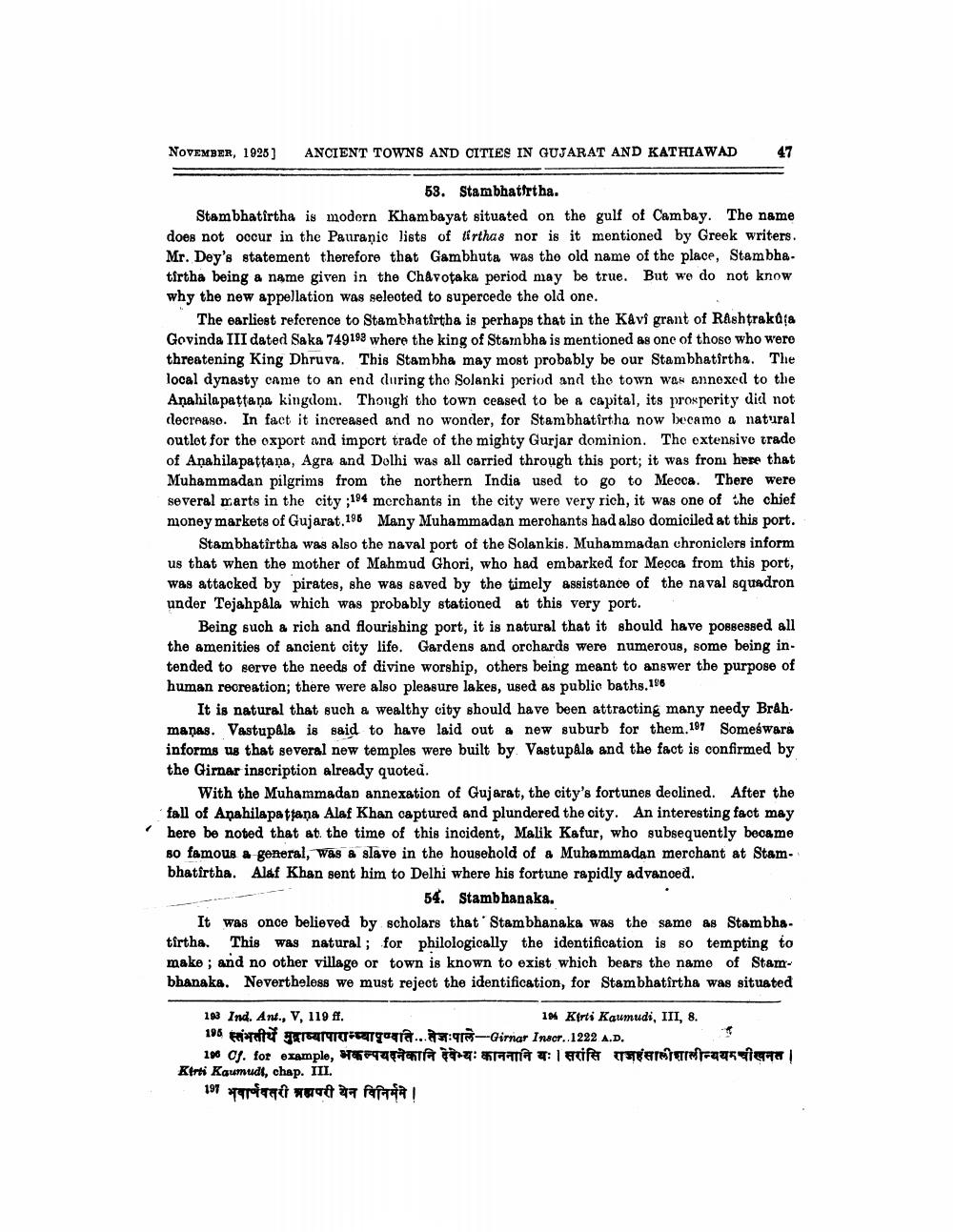________________
NOVEMBER, 1928)
ANCIENT TOWNS AND CITIES IN GUJARAT AND KATHIAWAD
47
53. Stambhatirtha. Stambhatirtha is modern Kham bayat situated on the gulf of Cambay. The name does not occur in the Pauranic lists of tirthas nor is it mentioned by Greek writers. Mr. Dey's statement therefore that Gambhuta was the old name of the place, Stambhatirtha being a name given in the Chavotaka period may be true. But we do not know why the new appellation was seleoted to supercede the old one.
The earliest reference to Stambhatirtha is perhaps that in the Kavi grant of Rashtrakara Govinda III dated Saka 749193 where the king of Stanbha is mentioned as one of those who were threatening King Dhruva. This Stambha may most probably be our Stambhatirtha. The local dynasty came to an end during the Solanki period and the town weh ennexed to the Anahilapattana kingilom. Though tho town ceased to be a capital, its prosperity did not decreaso. In fact it increased and no wonder, for Stambhatîrtha now becamo a natural outlot for the export and import trade of the mighty Gurjar dominion. The extensive trado of Anahilapattana, Agra and Dolhi was all carried through this port; it was from here that Muhammadan pilgrims from the northern India used to go to Mecca. There were several parts in the city 3194 merchants in the city were very rich, it was one of the chief money markets of Gujarat.196 Many Muhammadan merohants had also domiciled at this port.
Stambhatirtha was also the naval port of the Solankis. Muhammadan chroniclers inform us that when the mother of Mahmud Ghori, who had embarked for Mecca from this port, was attacked by pirates, she was saved by the timely assistance of the naval squadron under Tejahpala which was probably stationed at this very port.
Being such a rich and flourishing port, it is natural that it should have possessed all the amenities of ancient city life. Gardens and orchards were numerous, some being intended to serve the needs of divine worship, others being meant to answer the purpose of human recreation; there were also pleasure lakes, used as public baths.196
It is natural that such a wealthy city should have been attracting many needy Brah. manas. Vastupala is said to have laid out a new suburb for them. 187 Someswara informs us that several new temples were built by Vastupala and the fact is confirmed by the Girnar inscription already quoted.
With the Muhammadan annexation of Gujarat, the city's fortunes declined. After the fall of Anahilapattana Alaf Khan captured and plundered the city. An interesting fact may here be noted that at the time of this incident, Malik Kafur, who subsequently became 80 famous a general, was & slave in the household of a Muhammadan merchant at Stambhatîrtha. Alaf Khan sent him to Delhi where his fortune rapidly advanoed.
54. Stambhanaka. It was once believed by scholars that Stambhanaka was the same as Stambhatirtha. This was natural; for philologically the identification is so tempting to make; and no other village or town is known to exist which bears the name of Stambhanaka. Nevertheless we must reject the identification, for Stambhatirtha was situated
193 Ind. Ant., V, 119 ff. 196 piwo Tongagoare...:
196 of. for example, 7447 Ktrti Kaumudt, chap. III.
197 pritain Parafia !
104 Kirti Kaumudi, III, 8. -Girnar Inscr. 1222 A.D. 4:al rif T a traukiem




